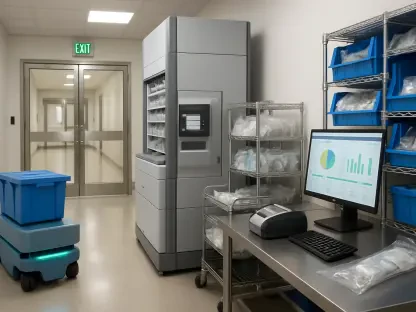The newly appointed Executive Director of the Mississippi Division of Medicaid, Cindy Bradshaw, recently provided state lawmakers with an insightful presentation on the current state, challenges, and future outlook of the Medicaid program in Mississippi. Her briefing addressed various concerns, shedding light on key areas such as the budget, enrollment trends, and administrative changes. Bradshaw’s comprehensive overview not only highlighted immediate issues but also showcased a strategic approach aimed at ensuring the program’s sustainability amidst dynamic and challenging circumstances.
Budget and Funding Overview
Mississippi’s Medicaid budget has reached an all-time high of over $8 billion this year. This significant figure comprises substantial federal funding combined with state contributions. The Federal Medical Assistance Percentage (FMAP), which currently stands at 76.9%, underscores the federal government’s major stake in the funding. This substantial federal participation is vital to sustaining the program, but potential reductions in the FMAP could pose financial challenges for the state, impacting overall budget allocations and resource distribution across various healthcare services.
Bradshaw elaborated on the potential reductions in FMAP. She emphasized that any decrease in federal contributions would significantly strain the state’s financial resources, potentially leading to difficult budgetary decisions. Such funding dynamics underscore the intricate balance that the Medicaid program in Mississippi must maintain, as it navigates both immediate operational needs and long-term fiscal responsibilities. This potential volatility in federal funding is a key concern for lawmakers as they strategize on managing both present obligations and future expansions of the program.
Leadership and Administrative Changes
Cindy Bradshaw’s appointment as Executive Director in October 2024 marked a new era for the Mississippi Division of Medicaid. Since taking office, Bradshaw has been tasked with navigating the complexities of the program following her predecessor, Drew Snyder. Her initial assessment of the administrative landscape has revealed areas ripe for improvement, particularly in enhancing efficiency and responsiveness within the Medicaid framework. Bradshaw provided legislators with a comprehensive overview of the administrative changes she intends to implement.
Bradshaw’s focus is on modernizing the administrative processes to ensure better alignment with federal regulations and to streamline service delivery. These initiatives are designed to enhance operational efficiency, reduce bureaucratic delays, and improve overall service quality. The strategic plans that Bradshaw is introducing involve leveraging technology, optimizing personnel performance, and ensuring that the program can adapt quickly to changing federal and state mandates. Her leadership aims to build a more resilient and efficient Medicaid program capable of better serving the needs of Mississippi’s citizens.
Enrollment Trends Amid the Pandemic
The COVID-19 pandemic significantly disrupted Medicaid enrollment processes across the nation, and Mississippi was no exception. Before the pandemic, the state’s Medicaid enrollment figures stood at approximately 730,000 individuals. However, the pandemic led to a surge in enrollment as eligibility checks were halted to quickly provide necessary healthcare access to many in need. During this period, enrollment numbers spiked to around 904,000, highlighting the substantial impact of the pandemic on the healthcare safety net provided by Medicaid.
Post-pandemic recalibration has now adjusted these figures to about 707,000 participants. This recalibration process involved reinstating eligibility checks and ensuring that those enrolled met the necessary criteria. Bradshaw explained that while the pandemic highlighted the critical role of Medicaid in providing healthcare access during emergencies, it also underscored the need for robust mechanisms to ensure that enrollment processes are accurate and that resources are allocated effectively. This reassessment phase is crucial for maintaining the integrity and sustainability of the Medicaid program in the long run.
Rising Costs and Future Projections
The costs associated with the Medicaid program in Mississippi have seen a notable rise over the years. Starting from approximately $6 billion five years ago, the budget has surged to $8.1 billion currently. Projections estimate that the budget could escalate to $9.9 billion within the next five years. This significant increase in expenses raises concerns about sustaining the program amid ongoing financial pressures and steadily increasing healthcare costs, which are influenced by various factors including inflation, population health needs, and policy changes.
Lawmakers were informed about these rising costs, expressing concerns about the potential financial strain on the state’s budget. The discussion highlighted the need for strategic financial planning and prudent resource management to ensure the program’s longevity. Bradshaw addressed these concerns by emphasizing that while rising healthcare costs are an inevitable trend, efforts are being made to improve efficiency, optimize resource allocation, and seek innovative solutions to manage these costs effectively. This approach aims to strike a balance between providing necessary healthcare services and maintaining fiscal responsibility.
Potential Federal Cuts and Implications
The looming threat of federal budget cuts to Medicaid could have severe implications for the state’s budget and its ability to provide healthcare services. Bradshaw explained to lawmakers that a potential 1% decrease in federal funding could require an additional $83 million from the state budget annually. This significant financial burden would necessitate difficult decisions regarding budget allocations and could potentially impact other critical state-funded programs. Legislators are carefully considering the implications of these potential cuts, especially in the context of possible Medicaid program expansions.
In addressing these concerns, Bradshaw emphasized the importance of proactive financial planning and legislative advocacy to mitigate the impact of potential federal funding reductions. She suggested that strategic efforts to secure additional federal support and to optimize the state’s Medicaid program for greater efficiency could help manage these challenges. The potential federal cuts highlight the need for ongoing dialogue between state and federal lawmakers to ensure sustainable funding streams for Medicaid and to safeguard the health and well-being of Mississippi’s vulnerable populations.
Vendor Management and Efficiency Improvements
The Division of Medicaid collaborates with several key vendors, including Gainwell Technologies, Conduent, and Telligen, each of which manages different aspects of the program such as fiscal processes, eligibility enrollment, and utilization management. This multi-vendor approach is intended to leverage specialized expertise and ensure that various components of the Medicaid program are managed effectively. However, Bradshaw highlighted the need for improving coordination among these vendors to enhance overall program efficiency and service delivery.
Streamlining vendor operations and improving efficiency are ongoing goals for the program management. Bradshaw emphasized that regular assessments and performance evaluations of these vendors are crucial for identifying areas of improvement and ensuring that contractual obligations are met. By fostering a culture of accountability and continuous improvement, the Division of Medicaid aims to optimize vendor performance, reduce administrative overhead, and enhance the quality of services provided to Medicaid beneficiaries. This focus on vendor management is integral to achieving better outcomes and ensuring the sustainability of the Medicaid program.
Addressing Administrative Staffing Needs
Mississippi’s Medicaid program operates with a relatively small workforce of fewer than one thousand employees. This small workforce is tasked with managing a complex and expansive Medicaid program that serves hundreds of thousands of individuals. Bradshaw underscored the need for streamlined administrative processes and efficient resource allocation to ensure that the program operates effectively despite limited staffing. Enhancing staff efficiency is critical for meeting the program’s vast responsibilities and ensuring the timely delivery of services to beneficiaries.
Bradshaw highlighted efforts to enhance staff efficiency through targeted training programs, process optimization, and the implementation of technology solutions to automate routine tasks. By investing in staff development and leveraging technology, the Division of Medicaid aims to increase productivity, reduce errors, and improve overall service quality. These initiatives are intended to build a more resilient and capable workforce that can adapt to evolving program requirements and respond effectively to the needs of Medicaid beneficiaries.
Concerns Raised by Lawmakers
During the briefing, several concerns were raised by lawmakers regarding the operational aspects of the Medicaid program. Representative Randy Boyd pointed out issues with incorrect information processed by vendors, which have affected eligibility verifications and resulted in administrative inefficiencies. Accurate and timely verification processes are essential to ensure that only eligible individuals receive Medicaid benefits.
Representative Stacey Wilkes discussed bureaucratic delays that lead to retroactive claim denials and reimbursement challenges for healthcare providers. These delays can create financial uncertainties for providers and impact their ability to deliver services to Medicaid beneficiaries. Bradshaw acknowledged these concerns and emphasized ongoing efforts to streamline administrative processes, improve communication with vendors, and enhance the accuracy of eligibility verifications and claim processing.
Safeguarding Against System Misuse
Cindy Bradshaw, the recently appointed Executive Director of the Mississippi Division of Medicaid, recently delivered an insightful presentation to state lawmakers. She addressed the current state of the Medicaid program in Mississippi, discussing its challenges and future outlook. Her briefing covered a wide array of concerns, shedding light on crucial areas such as budget issues, enrollment trends, and administrative changes. Bradshaw’s comprehensive overview not only highlighted pressing problems but also presented a strategic approach aimed at ensuring the program’s sustainability amid changing and challenging circumstances. By emphasizing a plan to navigate these complexities, Bradshaw illustrated how the Mississippi Medicaid program could adapt and thrive. She pointed out immediate issues while projecting a method for long-term sustainability, reflecting a balanced and proactive vision. Bradshaw’s detailed approach reassured the lawmakers, providing them with a clear understanding of the current situation and the future path of Mississippi’s Medicaid program.









